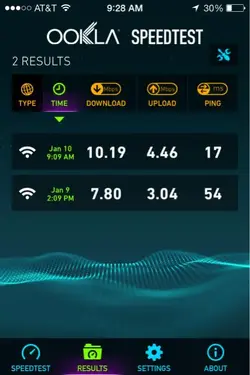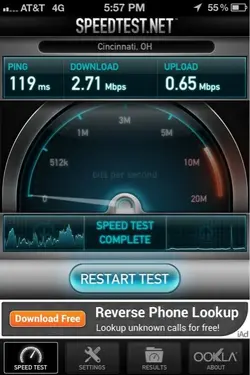Speed test
- Thread starter mardanros
- Start date

You are using an out of date browser. It may not display this or other websites correctly.
You should upgrade or use an alternative browser.
You should upgrade or use an alternative browser.
Speed test
- Thread starter mardanros
- Start date
On AT&T's HSPA 4G, those are decent speeds (If tested on HSPA). You see a larger percentage difference between the speeds and pings because of the time you logged these speeds. One being at a low, and one at peak hours.
Last edited:
xrayeyes
Well-Known Member
Looks like those were done over wifi? What speed do you have with your ISP? You should be getting close to what you are paying for!
zstairlessone
Well-Known Member
- Joined
- Feb 12, 2012
- Messages
- 2,643
- Reaction score
- 4,219
A Ping test measures the ability of your device to communicate with other computers over the Internet. The lower the ping number, the better the connection. You can use one of the many speed test apps available from the AppStore. I use speedtest.net. https://itunes.apple.com/ca/app/speedtest.net-mobile-speed/id300704847?mt=8What is a ping? Also, how do I check the ISP speed? How do I know if I have a good connection compared to what I payed. Also, This was done over Wi-Fi
Ping is a delay between the sending and receiving of data packets. It's extremely hard to gauge ISP speeds over wifi as all supposed advertised speeds are hardwired speeds meaning using an RJ45 cable from your router/modem to your computer.
Depending on the hour of the day, there are highs and lows, which reflects the amount of people also using the internet. Higher volumes of users generally results in lower speeds and slightly higher ping, and with lower volumes, the opposite.
Geographical location also matters. Prime example is how Verizon FiOs' speeds are planned at 15/5, 25/15, 50/25, (etc) and differs between area. In New York City, you'll be lucky to hit above 30 MBPS on a 50/25 plan. But in some parts of New Jersey an hour or two away, you can see a consistent 40+ and on occasion over 50 on a 50/25.
Wifi speeds will be slightly less than your purchased speed because it's not a direct 1 to 1 connection in the sense that it's not traveling through a cable medium. Interference and hardwired connections generally affect wifi speeds, and hardwired connections generally take priority over wifi speeds.
You can use Speedtest at non-peak hours and see what your speeds are like by pinging off of a local server rather than one a few thousand miles away, which usually yields the fastest possible measurement using Speedtest.net
Sent from my iPhone via Tapa
Depending on the hour of the day, there are highs and lows, which reflects the amount of people also using the internet. Higher volumes of users generally results in lower speeds and slightly higher ping, and with lower volumes, the opposite.
Geographical location also matters. Prime example is how Verizon FiOs' speeds are planned at 15/5, 25/15, 50/25, (etc) and differs between area. In New York City, you'll be lucky to hit above 30 MBPS on a 50/25 plan. But in some parts of New Jersey an hour or two away, you can see a consistent 40+ and on occasion over 50 on a 50/25.
Wifi speeds will be slightly less than your purchased speed because it's not a direct 1 to 1 connection in the sense that it's not traveling through a cable medium. Interference and hardwired connections generally affect wifi speeds, and hardwired connections generally take priority over wifi speeds.
You can use Speedtest at non-peak hours and see what your speeds are like by pinging off of a local server rather than one a few thousand miles away, which usually yields the fastest possible measurement using Speedtest.net
Sent from my iPhone via Tapa














